Have tick think it's exhaust manifold bolts broke off maybe if it's lifters will marvel mystery oil work got 0304 code changed plugs n coil still cylinder 4 dead how to get that back on replaced the sensors for cylinder deactivation n still changed evap leak detection monitor n purge valve still got small evap leak code 0456 


You are using an out of date browser. It may not display this or other websites correctly.
You should upgrade or use an alternative browser.
You should upgrade or use an alternative browser.
2012 jeep grand Cherokee srt8
- Thread starter nemo41
- Start date
No, switching oil won't fix broken exhaust manifold bolts. And if cylinder 4 is dead, a compression test is in order on #4.
More like pull valve cover and check valve lift on that cylinder
OVERKILL
$100 Site Donor 2021
Pause. Breathe.Have tick think it's exhaust manifold bolts broke off maybe if it's lifters will marvel mystery oil work got 0304 code changed plugs n coil still cylinder 4 dead how to get that back on replaced the sensors for cylinder deactivation n still changed evap leak detection monitor n purge valve still got small evap leak code 0456
Do a compression test on that cylinder to start with. Leave the wizards on the shelf, if it lunched a lifter, you need a cam and lifters.
Running Compression Tests
Firing on All Cylinders?
RUNNING COMPRESSION TEST IS A GREAT TOOL FOR DIAGNOSING DENSITY MISFIRES
Running a compression test or dynamic compression test is an important, but little-used and often overlooked engine diagnostic tool. Why is this test so significant? It can be used to pinpoint the cause of a misfire when all the usual tests return normal results. It’s also used by performance tuners to verify that each cylinder is contributing equally to the engine’s overall power output.When you perform a static compression or cylinder leak-down test, you’re checking the sealing capability of each cylinder. A vacuum test is a great way to determine an engine’s overall breathing capabilities but does not provide results for individual cylinders. The advantage of a running compression test is that it gives you an idea of the volumetric efficiency of each cylinder. In other words, how efficiently each cylinder is pulling air in, retaining it for the correct amount of time, then releasing it into the exhaust. If a cylinder cannot perform these functions properly, the result can be a loss of volumetric efficiency or a density misfire.
HOW TO PERFORM THE TEST
- Create a chart similar to this example to record your test readings.
CYL STATIC IDLE SNAP 1 2 3 4 - Begin with a normal ("static") compression test on a warm engine to eliminate obvious problems such as badly worn rings, burnt or bent valves or holes in pistons. If you have a diagnostic trouble code, you may know which cylinder is misfiring, but it’s a good idea to test the compression of all the cylinders in that bank to get a good comparison. Record your static compression readings.
- Install all of the spark plugs except the one for the suspected cylinder.
WARNING: GROUND THAT PLUG WIRE TO PREVENT MODULE DAMAGE, OR WHEN EQUIPPED WITH A COIL-ON-PLUG IGNITION, SIMPLY DISCONNECT THE COIL HARNESS PLUG. - Disconnect the injector for that cylinder on a port fuel injection system.
- Install your compression tester in the suspected cylinder. The test can be done with the Schrader valve removed, but most techs recommend leaving the valve in the gauge and "burping" the gauge every 5-6 "puffs".
- Start the engine and take an “Idle” reading. Be sure the idle speed is a consistent 1200 rpm. Record the results.
- Now, from 1200 rpm, snap the throttle to 2500 rpm and release quickly. Reading should rise. Record the results.
NOTE: Don't use the gas pedal for this snap acceleration. The idea is to manually open then close throttle as fast as possible, forcing the engine to take a "gulp" of air.
SAMPLE TEST READINGS
Comparing measurements between cylinders is important. Running compression at idle should be 50-75 PSI (about half cranking compression). Snap throttle compression should be about 80% of cranking compression. Let’s analyze the results from the following sample test readings.| EXAMPLE 1 | |||
| CYL | STATIC | IDLE | SNAP |
| 1 | 150 | 75 | 85 |
| 2 | 175 | 80 | 130 |
| 3 | 160 | 75 | 120 |
| 4 | 160 | 80 | 120 |
| EXAMPLE 2 | |||
| CYL | STATIC | IDLE | SNAP |
| 1 | 150 | 75 | 130 |
| 2 | 175 | 80 | 130 |
| 3 | 160 | 75 | 120 |
| 4 | 160 | 80 | 175 |
| EXAMPLE 3 | |||
| CYL | STATIC | IDLE | SNAP |
| 1 | 150 | 75 | 130 |
| 2 | 175 | 40 | 90 |
| 3 | 160 | 75 | 120 |
| 4 | 160 | 80 | 175 |
As you can see, information gathered from a running compression test can be very helpful when diagnosing misfires and tuning for total engine performance. It’s a great test to add to your diagnostic arsenal.
**You have no choice on a electronic throttle body design than to use the gas pedal for snap throttle testing.
Have tick think it's exhaust manifold bolts broke off maybe if it's lifters will marvel mystery oil work got 0304 code changed plugs n coil still cylinder 4 dead how to get that back on replaced the sensors for cylinder deactivation n still changed evap leak detection monitor n purge valve still got small evap leak code 0456
There are many different methods of EVAP leak detection.... I use a Flow Meter which is built into my smoke machine. But first you must seal the system. On Chrysler products that means sealing off the Natural Leak Detection Pump or Evaporative System Integrity Module from venting under pressure. If the Flow Meter doesn't eventually drop to zero.....You have a leak that a NLDP or ESIM will not fix.
Did a compression test no compression changed cylinder deactivation solenoids also got rid of evap code tho noticed other day when I did purge n Evap leak detector I mean will marvel mystery oil free up the lifter maybe hopefullyPause. Breathe.
Do a compression test on that cylinder to start with. Leave the wizards on the shelf, if it lunched a lifter, you need a cam and lifters.
Post the results of each cylinder please.Did a compression test no compression changed cylinder deactivation solenoids also got rid of evap code tho noticed other day when I did purge n Evap leak detector I mean will marvel mystery oil free up the lifter maybe hopefully
And punctuation is your friend.
Punctuation is OUR friend.Post the results of each cylinder please.
And punctuation is your friend.
Without it, we have only a vague idea of what the original poster is saying.
Even more unclear: is there a question in all these blocks of run on text.
OVERKILL
$100 Site Donor 2021
Sounds like you've lost a lobe and lifter, no wizard in a can is going to help with that. Pull the valve cover, roll it over, see if you have any actuation on the dead cylinder.Did a compression test no compression changed cylinder deactivation solenoids also got rid of evap code tho noticed other day when I did purge n Evap leak detector I mean will marvel mystery oil free up the lifter maybe hopefully
Sounds like you've lost a lobe and lifter, no wizard in a can is going to help with that. Pull the valve cover, roll it over, see if you have any actuation on the dead cylinder.
Attachments
-
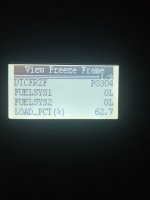 IMG_20221204_173535349_HDR.jpg92.5 KB · Views: 4
IMG_20221204_173535349_HDR.jpg92.5 KB · Views: 4 -
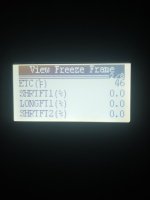 IMG_20221204_173559814_HDR.jpg45.9 KB · Views: 4
IMG_20221204_173559814_HDR.jpg45.9 KB · Views: 4 -
 IMG_20221204_173603963_HDR.jpg46.3 KB · Views: 3
IMG_20221204_173603963_HDR.jpg46.3 KB · Views: 3 -
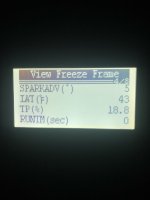 IMG_20221204_173610180_HDR.jpg50.9 KB · Views: 3
IMG_20221204_173610180_HDR.jpg50.9 KB · Views: 3 -
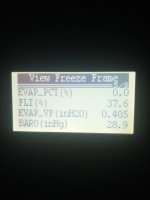 IMG_20221204_173615315_HDR.jpg48.9 KB · Views: 3
IMG_20221204_173615315_HDR.jpg48.9 KB · Views: 3 -
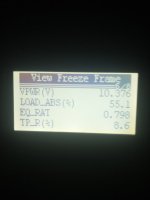 IMG_20221204_173620972_HDR.jpg44.6 KB · Views: 3
IMG_20221204_173620972_HDR.jpg44.6 KB · Views: 3 -
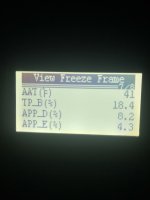 IMG_20221204_173626655_HDR.jpg50.7 KB · Views: 3
IMG_20221204_173626655_HDR.jpg50.7 KB · Views: 3 -
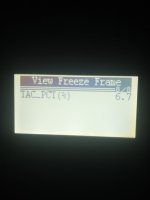 IMG_20221204_173630371_HDR.jpg38.2 KB · Views: 4
IMG_20221204_173630371_HDR.jpg38.2 KB · Views: 4
OVERKILL
$100 Site Donor 2021
You will need to physically take a look unfortunately, a scan tool isn't going to give you a definitive answer.
D
Deleted member 89374
DON'T USE MARVEL MYSTERY OIL!Did a compression test no compression changed cylinder deactivation solenoids also got rid of evap code tho noticed other day when I did purge n Evap leak detector I mean will marvel mystery oil free up the lifter maybe hopefully
I hope that was clear enough.
If you don't want to physically tough the engine, as in take a look inside, then the next best thing is to attempt a cleaning with a fully formulate motor oil blended with cleaning esters.
Your engine takes rounded 8 quarts of oil. I know it can run 8 quarts with the big filter for sure.
Go to Walmart, buy 6 quarts of Mobil 1 FS 0W-40 (get it by the quart or 5-quart jug, you do the math).
Go here and order two quarts of Engine Cleaner: https://www.advlubrication.com/coll...roducts/engine-cleaner?variant=40840726315201
HPL Engine Cleaner is a fully formulated motor oil that contains a higher concentration of cleaning esters.
Put in the two quarts of Engine Cleaner and six quarts of Mobil 1 FS 0W-40. BTW, you can get the SAE 30 Engine Cleaner, you don't need the 40. The 40 is a bit thicker.
After 2000 miles either change the oil with the oil of your choice, or run Mobil 1 FS 0W-40 without engine cleaner. Alternatively, after 2000 miles just replace the oil filter with a new one and let the Engine Cleaner keep working. It will free up whatever gunk, dirt, debris, or sludge you have in that engine.
I am advising you to do this because your engine is a big unknown to us. We don't know its history, or anything about it. So this would be the safest route for you.
Forget Pennzoil and other oils or playing around with mild viscosity changes. That won't accomplish anything either.
Neither will using Red Line, though Red Line, like Mobil 1 FS 0W-40, contains Esters and just like Mobil 1, has a mild cleaning ability.
Finally, you've come to the best place to get advice. It's up to you if you follow through with the recommendations or not.
@OVERKILL and @clinebarger have infinitely more knowledge about HEMI engines than I do. My advice is just a simple and lazy approach: do some cleaning before doing anything invasive.
[Edit]
I wasn't paying enough attention to Post #9. My advice here is not useful given the OP's current situation.
Last edited by a moderator:
Not sure why you bothered to write this - it is pointless. There is zero reason to "try" chemical remedies when there is a clear mechanical issue.DON'T USE MARVEL MYSTERY OIL!
I hope that was clear enough.
If you don't want to physically tough the engine, as in take a look inside, then the next best thing is to attempt a cleaning with a fully formulate motor oil blended with cleaning esters.
Your engine takes rounded 8 quarts of oil. I know it can run 8 quarts with the big filter for sure.
Go to Walmart, buy 6 quarts of Mobil 1 FS 0W-40 (get it by the quart or 5-quart jug, you do the math).
Go here and order two quarts of Engine Cleaner: https://www.advlubrication.com/coll...roducts/engine-cleaner?variant=40840726315201
HPL Engine Cleaner is a fully formulated motor oil that contains a higher concentration of cleaning esters.
Put in the two quarts of Engine Cleaner and six quarts of Mobil 1 FS 0W-40. BTW, you can get the SAE 30 Engine Cleaner, you don't need the 40. The 40 is a bit thicker.
After 2000 miles either change the oil with the oil of your choice, or run Mobil 1 FS 0W-40 without engine cleaner. Alternatively, after 2000 miles just replace the oil filter with a new one and let the Engine Cleaner keep working. It will free up whatever gunk, dirt, debris, or sludge you have in that engine.
I am advising you to do this because your engine is a big unknown to us. We don't know its history, or anything about it. So this would be the safest route for you.
Forget Pennzoil and other oils or playing around with mild viscosity changes. That won't accomplish anything either.
Neither will using Red Line, though Red Line, like Mobil 1 FS 0W-40, contains Esters and just like Mobil 1, has a mild cleaning ability.
Finally, you've come to the best place to get advice. It's up to you if you follow through with the recommendations or not.
@OVERKILL and @clinebarger have infinitely more knowledge about HEMI engines than I do. My advice is just a simple and lazy approach: do some cleaning before doing anything invasive.
OVERKILL
$100 Site Donor 2021
Yup, that mirrors my thoughts, as noted.You’re wasting time and money on anything that doesn’t involve disassembly
Similar threads
- Replies
- 39
- Views
- 3K
- Replies
- 46
- Views
- 4K
- Locked
- Replies
- 127
- Views
- 12K
- Replies
- 84
- Views
- 5K
- Replies
- 40
- Views
- 25K
